
Alan LaVern Bean was an American naval officer and aviator, aeronautical engineer, test pilot, NASA astronaut and painter; he was the fourth person to walk on the Moon. He was selected to become an astronaut by NASA in 1963 as part of Astronaut Group 3.

The Robert J. Collier Trophy is an annual aviation award administered by the U.S. National Aeronautic Association (NAA), presented to those who have made "the greatest achievement in aeronautics or astronautics in America, with respect to improving the performance, efficiency, and safety of air or space vehicles, the value of which has been thoroughly demonstrated by actual use during the preceding year."

John Leonard Swigert Jr. was an American NASA astronaut, test pilot, mechanical engineer, aerospace engineer, United States Air Force pilot, and politician. In April 1970, as command module pilot of Apollo 13, he became one of twenty-four astronauts who flew to the Moon.

Joe Henry Engle is an American pilot, aeronautical engineer and former NASA astronaut. He was the commander of two Space Shuttle missions including STS-2 in 1981, the program's second orbital flight. He also flew three flights in the Shuttle program's 1977 Approach and Landing Tests. Engle is one of twelve pilots who flew the North American X-15, an experimental spaceplane jointly operated by the Air Force and NASA.
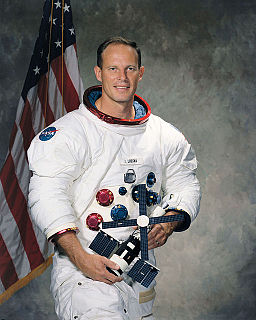
Col. Jack Robert Lousma USMC, Ret. is an American astronaut, aeronautical engineer, retired United States Marine Corps officer, former naval aviator, NASA astronaut, and politician. He was a member of the second crew, Skylab-3, on the Skylab space station in 1973. In 1982, he commanded STS-3, the third Space Shuttle mission. Lousma was inducted into the United States Astronaut Hall of Fame in 1997. He is the last living crew member of both of his spaceflights.

Paul Joseph Weitz was an American naval officer and aviator, aeronautical engineer, test pilot, and NASA astronaut, who flew into space twice. He was a member of the three-man crew who flew on Skylab 2, the first crewed Skylab mission. He was also Commander of the STS-6 mission, the maiden flight of the Space Shuttle Challenger.

Owen Kay Garriott was an American electrical engineer and NASA astronaut, who spent 60 days aboard the Skylab space station in 1973 during the Skylab 3 mission, and 10 days aboard Spacelab-1 on a Space Shuttle mission in 1983.

Colonel Gerald Paul Carr was an American mechanical and aeronautical engineer, United States Marine Corps officer, naval aviator, and NASA astronaut. He was Commander of Skylab 4, the third and final crewed visit to the Skylab Orbital Workshop, from November 16, 1973, to February 8, 1974.
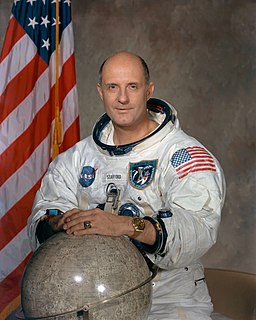
Thomas Patten Stafford is an American former Air Force officer, test pilot, and NASA astronaut, and one of 24 people who flew to the Moon. He also served as Chief of the Astronaut Office from 1969 to 1971.

Joseph Albert Walker was an American World War II pilot, experimental physicist, NASA test pilot, and astronaut. He was one of twelve pilots who flew the North American X-15, an experimental spaceplane jointly operated by the Air Force and NASA.

Albert Scott Crossfield was an American naval officer and test pilot. In 1953, he became the first pilot to fly at twice the speed of sound. Crossfield was the first of twelve pilots who flew the North American X-15, an experimental spaceplane jointly operated by the United States Air Force and NASA.

William Harvey "Bill" Dana was an American aeronautical engineer, U.S. Air Force pilot, NASA test pilot, and astronaut. He was one of twelve pilots who flew the North American X-15, an experimental spaceplane jointly operated by the Air Force and NASA. He was also selected for participation in the X-20 Dyna-Soar program.
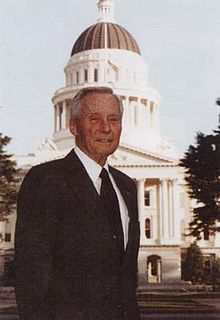
William John "Pete" Knight was an American aeronautical engineer, politician, Vietnam War combat pilot, test pilot, and astronaut. He was one of twelve pilots who flew the North American X-15, an experimental spaceplane jointly operated by the U.S. Air Force and NASA. He was also selected for participation in the X-20 Dyna-Soar program.

Milton Orville Thompson, , better known as Milt Thompson, was an American naval officer, aviator, engineer, and NASA research pilot. He was one of twelve pilots who flew the North American X-15, an experimental spaceplane jointly operated by the United States Air Force and NASA. He was also selected for participation in the X-20 Dyna-Soar program.
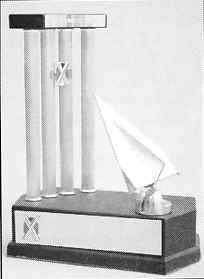
The Iven C. Kincheloe Award recognizes outstanding professional accomplishment in the conduct of flight testing. It was established in 1958 by the Society of Experimental Test Pilots in memory of test pilot and Korean War ace Iven C. Kincheloe, United States Air Force, who died during flight testing.

Theodore Cordy "Ted" Freeman, was an American aeronautical engineer, U.S. Air Force officer, test pilot, and NASA astronaut. Selected in the third group of NASA astronauts in 1963, he was killed a year later in the crash of a T-38 jet, marking the first fatality among the NASA Astronaut Corps. At the time of his death, he held the rank of captain.
Alvin Swauger White was an American test pilot and mechanical engineer. He flew the maiden flights of both XB-70 Valkyrie aircraft, the first 2,000 mph (3,200 km/h) flight, and all subsequent Mach 3 exploration flights.

Joseph John "Tym" Tymczyszyn was an American World War II pilot, and test pilot for the United States Army Air Corps and the Federal Aviation Administration.
William H. "Bill" McAvoy was a civilian test pilot in the 1920s and 1930s for the National Advisory Committee for Aeronautics (NACA) at the Langley Memorial Aeronautical Laboratory, Langley Field, Virginia, and in 1940 helped start the flight operations division at the Ames Research Center, California.
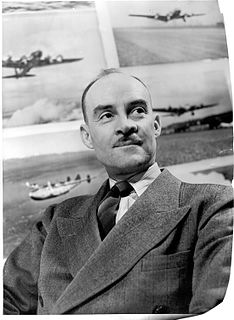
Edmund Turney Allen was a pioneer of modern flight test who flew for nearly every major American aircraft manufacturer and took some of the most famous planes of all time up for their first flights.


















